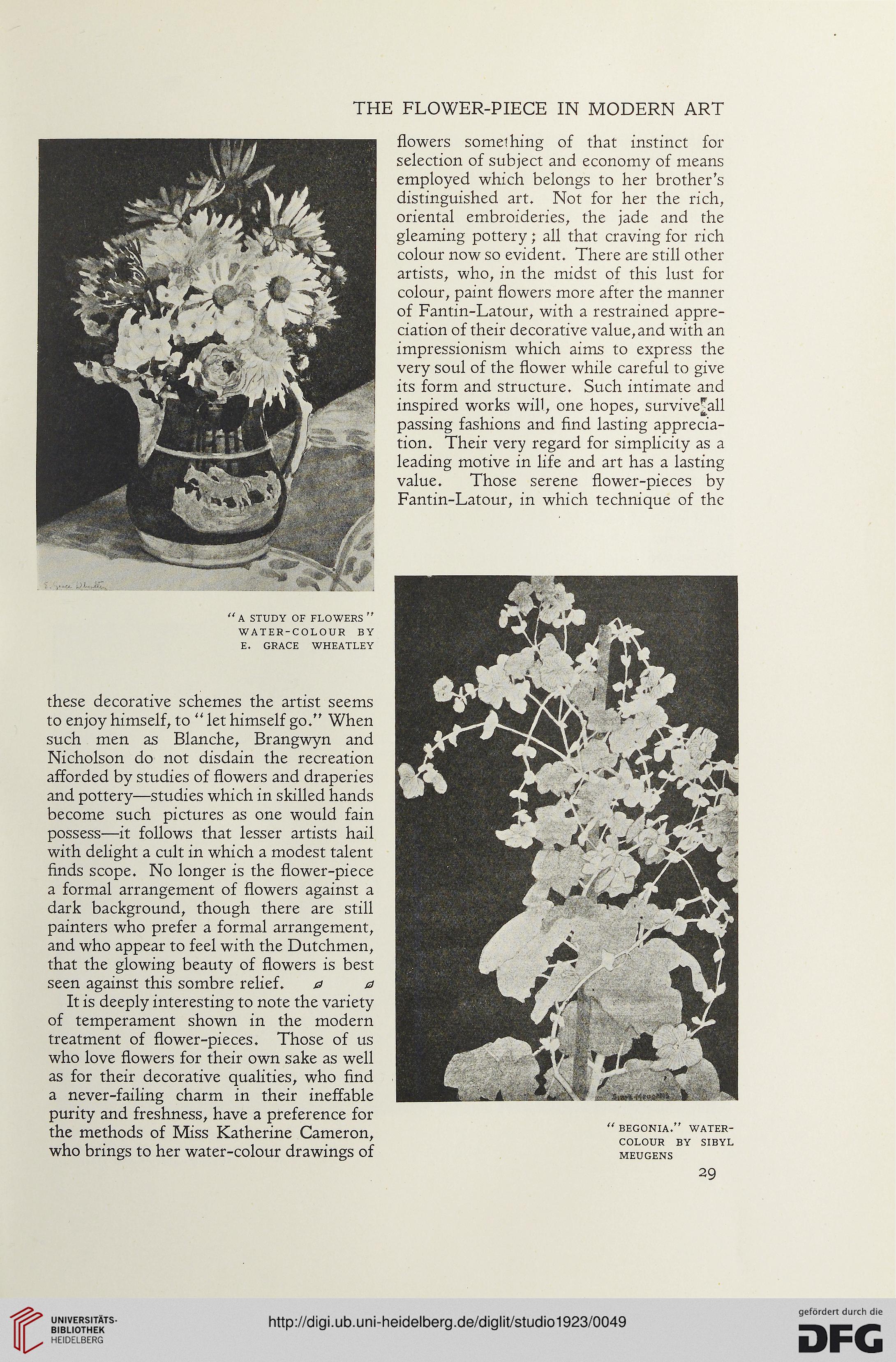THE FLOWER-PIECE IN MODERN ART
"a study of flowers”
WATER-COLOUR BY
E. GRACE WHEATLEY
these decorative schemes the artist seems
to enjoy himself, to ** let himself go ” When
such men as Blanche, Brangwyn and
Nicholson do not disdain the recreation
afforded by studies of flowers and draperies
and pottery—studies which in skilled hands
become such pictures as one would fain
possess—it follows that lesser artists hail
with delight a cult in which a modest talent
finds scope. No longer is the flower-piece
a formal arrangement of flowers against a
dark background, though there are still
painters who prefer a formal arrangement,
and who appear to feel with the Dutchmen,
that the glowing beauty of flowers is best
seen against this sombre relief. a a
It is deeply interesting to note the variety
of temperament shown in the modern
treatment of flower-pieces. Those of us
who love flowers for their own sake as well
as for their decorative qualities, who find
a never-failing charm in their ineffable
purity and freshness, have a preference for
the methods of Miss Katherine Cameron,
who brings to her water-colour drawings of
flowers something of that instinct for
selection of subject and economy of means
employed which belongs to her brother's
distinguished art. Not for her the rich,
oriental embroideries, the jade and the
gleaming pottery; all that craving for rich
colour now so evident. There are still other
artists, who, in the midst of this lust for
colour, paint flowers more after the manner
of Fantin-Latour, with a restrained appre-
ciation of their decorative value, and with an
impressionism which aims to express the
very soul of the flower while careful to give
its form and structure. Such intimate and
inspired works will, one hopes, survive^all
passing fashions and find lasting apprecia-
tion. Their very regard for simplicity as a
leading motive in life and art has a lasting
value. Those serene flower-pieces by
Fantin-Latour, in which technique of the
BEGONIA.” WATER-
COLOUR BY SIBYL
MEUGENS
29
"a study of flowers”
WATER-COLOUR BY
E. GRACE WHEATLEY
these decorative schemes the artist seems
to enjoy himself, to ** let himself go ” When
such men as Blanche, Brangwyn and
Nicholson do not disdain the recreation
afforded by studies of flowers and draperies
and pottery—studies which in skilled hands
become such pictures as one would fain
possess—it follows that lesser artists hail
with delight a cult in which a modest talent
finds scope. No longer is the flower-piece
a formal arrangement of flowers against a
dark background, though there are still
painters who prefer a formal arrangement,
and who appear to feel with the Dutchmen,
that the glowing beauty of flowers is best
seen against this sombre relief. a a
It is deeply interesting to note the variety
of temperament shown in the modern
treatment of flower-pieces. Those of us
who love flowers for their own sake as well
as for their decorative qualities, who find
a never-failing charm in their ineffable
purity and freshness, have a preference for
the methods of Miss Katherine Cameron,
who brings to her water-colour drawings of
flowers something of that instinct for
selection of subject and economy of means
employed which belongs to her brother's
distinguished art. Not for her the rich,
oriental embroideries, the jade and the
gleaming pottery; all that craving for rich
colour now so evident. There are still other
artists, who, in the midst of this lust for
colour, paint flowers more after the manner
of Fantin-Latour, with a restrained appre-
ciation of their decorative value, and with an
impressionism which aims to express the
very soul of the flower while careful to give
its form and structure. Such intimate and
inspired works will, one hopes, survive^all
passing fashions and find lasting apprecia-
tion. Their very regard for simplicity as a
leading motive in life and art has a lasting
value. Those serene flower-pieces by
Fantin-Latour, in which technique of the
BEGONIA.” WATER-
COLOUR BY SIBYL
MEUGENS
29




